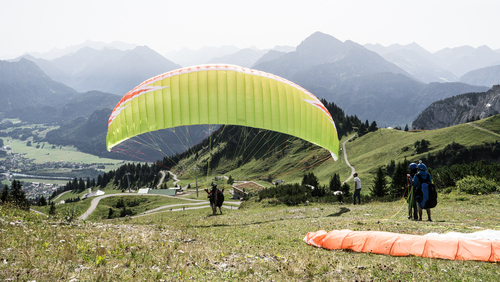
Easy to launch. Simple launch characteristics are some of the most important aspects of a tandem wing. During the development of the BION, this criteria was very important to us. The result is a wing which inflates continuously and manageably over the pilot and passenger. The take off speed is pleasantly low.
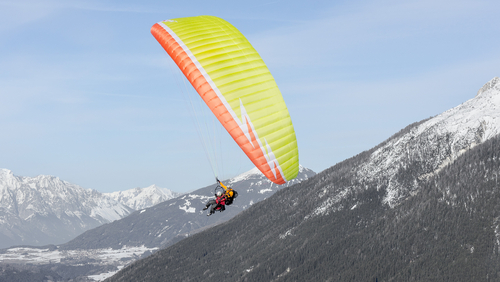 Tandempilot Lorenz Peer mit Nova Bion. Neustift im Stubaital.
Tandempilot Lorenz Peer mit Nova Bion. Neustift im Stubaital.Balanced in the air. Unlike solo wings, tandem gliders have to cope with a very large weight-range. Whether flown at the top or bottom of the weight-range, the glider has to remain easy to steer and must not develop high brake pressure. The BION offers the full package of pleasant handling across the entire weight-range as well as maintaining low break pressure.
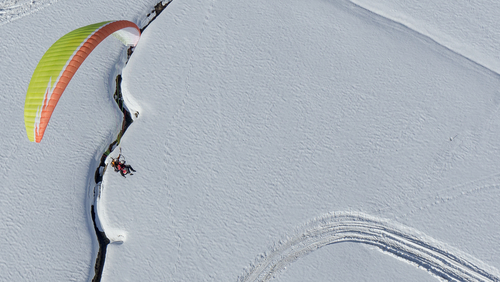 Tandempilot Lorenz Peer mit Nova Bion. Neustift im Stubaital.
Tandempilot Lorenz Peer mit Nova Bion. Neustift im Stubaital.No surprises. Anyone flying tandem not only has responsibility for themselves - they have to offer their passenger a safe experience too. This was our main concern when developing the BION. Thanks to its low aspect ratio its extreme flight behaviour is very manageable. The BION offers a very high degree of passive safety.
The BION technolgy
Technical data
| 33 | 37 | ||
|---|---|---|---|
| Number of cells | - | 43 | 43 |
| Projected span | m | 10,67 | 11,32 |
| Projected area | m² | 32,4 | 36,44 |
| Projected aspect ratio | - | 3,52 | 3,52 |
| Flat span | m | 14,18 | 15,05 |
| Flat area | m² | 39,1 | 44 |
| Flat aspect ratio | - | 5,14 | 5,14 |
| Line diameter | mm | 1,1 / 2,15 / 3,15 | |
| Line length | m | 7,67 | 8,14 |
| Total line length | m | 426 | 452 |
| Max. chord | m | 3,47 | 3,66 |
| Min. chord | m | 0,71 | 0,75 |
| Weight | kg | 7,5 | 8,5 |
| Recommended take off weight | kg | 90-200 | 115-230 |
| Certification (EN/LTF) | - | B | B |
Materials
| Leading edge: | Porcher Sport 9092 E75A 45 g/m² |
|---|---|
| Top surface: | DOKDO 30 DMF WR 41 g/m² |
| Bottom surface: | DOKDO 30 DMF WR 41 g/m² |
| Profile ribs (with line suspension point): | DOKDO 30 DFM RIB 41 g/m² |
| Profile ribs (without line suspension point): | DOKDO 30 DFM WR 41 g/m² |
| Main lines: | Edelrid A-6843-340 (Aramid); Edelrid A-6843-240 (Aramid) |
| Gallery lines: | Cousine 85 (Dyneema) |
| Brake lines: | Liros PPSL 120 (Dyneema); Edelird A-7850-360 (Dyneema) |
| Risers: | Guth & Wolf, 25 mm |
Serwis
Każda paralotnia NOVA jest sprzedawana wraz z dodatkowymi usługami i gwarancjami. Przy zakupie skrzydła dostajesz coś więcej niż sam produkt1.
Podczas pierwszych lotów linki są wpływem prawdziwych obciążeń po raz pierwszy. Prowadzi to do rozciągania i skurczenia linek – niezależnie od tego, jaki materiał został użyty. Podczas NOVA Trim Tuning2 nasze oprogramowanie analizuje w jaki sposób trymować Twoje skrzydło i oblicza odpowiedni wartości do korekty. Trim Tuning wspomaga bezpieczeństwo i zwiększa przyjemność z latania.
Po zakupie skrzydła i udanej rejestracji w myNOVA otrzymasz pełne, kompleksowe ubezpieczenie na rok (koszt: 63,50 euro razem z podatkiem VAT / + wysyłka i zapakowanie3). Przy uszkodzeniu skrzydła my pokrywamy koszty naprawy. NOVA Protect oznacza, że możesz w pełni skupić się na tym, co ważne: na lataniu! Przy szkodzie my naprawimy!
NOVA Full Service to coś więcej niż tylko sprawdzenie. Podobnie jak przy Trim Tuning analizujemy długości linek i upewniamy się, że skrzydło utrzymuje optymalny profil na całej długości. Dodatkowo poddajemy skrzydło pełnemu przeglądowi. Nasza usługa NOVA Full Service daje Ci poczucie pewności Twojego skrzydła.
Jeśli Twoje skrzydło przeszło przez NOVA Trim Tuning, to kolejna data sprawdzenia jest przedłużona z dwóch do trzech lat. Dwuletnie sprawdzenie staje się trzyletnim. Dzięki temu zyskujesz dodatkowy rok beztroskiego latania. Proszę zwrócić uwagę na maksymalną ilość godzin w powietrzu wyszczególnionych w instrukcji.
W standardzie NOVA oferuje trzyletnią gwarancję, zamiast dwuletniej. Natomiast jeśli twoje skrzydło przeszło przez NOVA Trim Tuning oraz NOVA Full Service, to przedłużymy gwarancję o kolejny rok, w sumie do czterech lat. Latając na paralotniach NOVA ma się dobre samopoczucie.
Podczas rejestracji skrzydła w myNOVA jest ono dodawane do Quality Assurance Database. Z tej bazy danych, do której masz dostęp przez myNOVA, możesz ściągnąć wszystkie ważne informacje na temat swojego skrzydła. Baza danych również wspomaga osobę serwisującą Twoją paralotnię dzięki dostępowi do informacji za jednym kliknięciem. Twoje skrzydło zostanie dzięki temu bardziej dokładnie sprawdzone.
1 Gwarancja i świadczenie usług są ograniczone, podlegają warunkom i nie są oferowane w takim samym zakresie we wszystkich krajach. Szczegółowe informacje znajdziesz w naszych warunkach gwarancji.
2 Ta usługa jest wliczona w cenę zakupu w wybranych krajach. Aby uzyskać więcej informacji, skontaktuj się ze sprzedawcą.
FAQ
Performance data depends heavily on the drag created by the pilot and this is linked to their seating position and harness type. An aerodynamic harness or seating position can make the difference of one glide ratio point. We at NOVA never determine absolute performance data, instead we make comparisons with reference gliders. For this reason we do not publish performance data.
The brakes are components relevant to certification - modification can affect the flying characteristics and extreme flight behaviour. Because of this, we strongly advise against any modification of the brake system. It is important that the brake has sufficient travel before it engages. This is also important so that the wing does not brake automatically when the speed bar is used. Furthermore a brake that engages too early affects performance and influences the recovery during incidents, for example during a collapse or when the canopy goes parachutal.
Simplicity is our motto. Our wings can be packed using a concertina bag, but it is not essential. You can fold this wing using your preferred method and pack it in our stuff sack. Be careful not to bend the leading edge rods unnecessarily. This is particularly true if the wing is to be stored for longer periods or if it is packed tightly.
Sail cloth, lines and all other components are subjected to rigorous testing before they are used in serial production. We not only test the sail cloth for durability (high porosity or reduced tear resistance through UV damage or wear) but also for mechanical robustness, for example stretching. For quality control purposes we regularly take samples during serial production.
During the initial flights the lines are first subjected to load. This load induces a small degree of stretching and shrinking. These are not associated with the line manufacturers or the quality of workmanship - in the factory all NOVA paragliders are trimmed and pre-stretched to within a very low tolerance. To adjust this stretching or shrinking, we recommend that the wing is taken for NTT (NOVA Trim Tuning) after ten to twenty flights - after one year at the very latest. Generally, the line lengths remain constant after the first ten to twenty hours. To make full use of the NTT, NOVA encourages all pilots to have their wing checked after ten to twenty flying hours.
Dry, not packed too tightly and if possible in a space without wide temperature variations - these are the conditions that make our paragliders feel well. You should never store a wing when it is moist. You should also avoid excessive heat, like you would have, for example, in the car. Never remove dirt using chemical detergents and/or brushes.
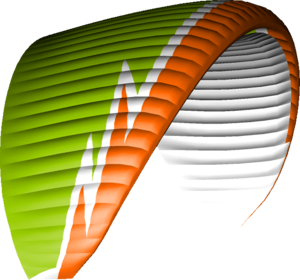 Green Fizz
Green Fizz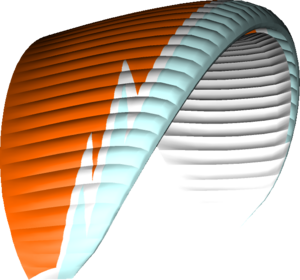 Orange Flux
Orange Flux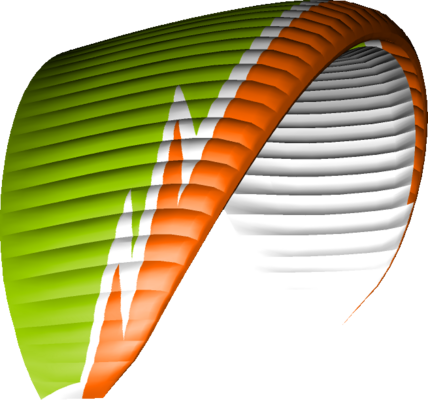







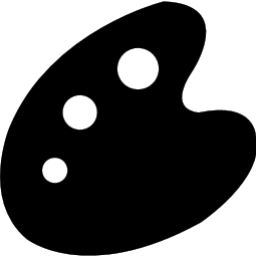

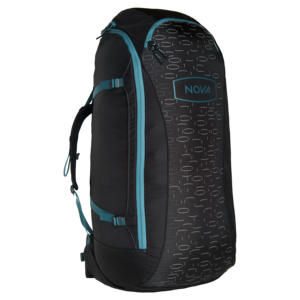 NOVA Rucksack.
NOVA Rucksack.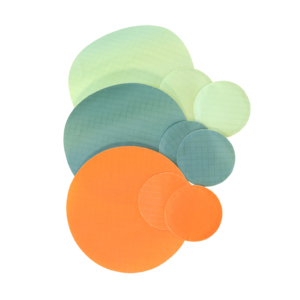 Repair kit.
Repair kit.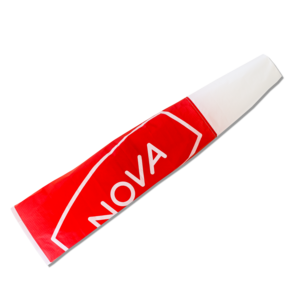 NOVA windsock.
NOVA windsock. Manual.
Manual.